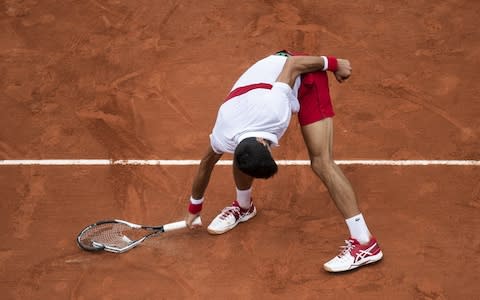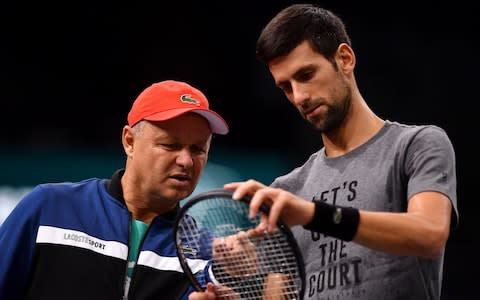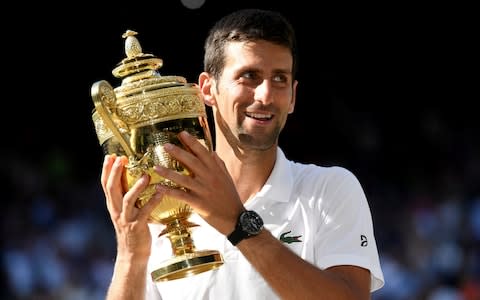How Novak Djokovic went from rock bottom to world No. 1
If the last couple of years have taught us anything, it's that mountain walks to clear your head can go massively one of two ways.
On the one hand we have Theresa May's hiking holiday in Snowdonia which prompted her disastrous decision to call a general election in 2017; on the other there's Novak Djokovic, who puts his mid-season transformation this year down to a revitalising trip to the French Alps in June.
"When we were climbing one of these mountains, I remember that moment, I was sitting and just breathing in the fresh air and looking at the world from that perspective," Djokovic explained in the aftermath of his US Open win.
READ MORE: Tennis - Inspired Khachanov stuns Djokovic to claim Paris title
READ MORE: Tennis - Maiden title for Kumkhum in Mumbai
"I thought of tennis and the emotion that tennis provokes in me and I felt that passion again. It was a turning point for sure."
Only a few days previously, Djokovic had suffered a meltdown in front of the assembled press after a shock French Open defeat to Marco Cecchinato. "I don’t know if I’m going to play on grass," Djokovic ranted in a media conference that lasted only four and a half minutes and was called so hastily that it had to take place in the small interview room.

The difference in results since then and after the trip to the Montagne Sainte-Victoire are striking. Up until that point Djokovic boasted no titles, no finals and a win-loss record of 14-8 . He has since won four titles - two grand slams and two Masters - and posted a win-loss record of 35-3. Until losing to Karen Khachanov on Sunday in the Paris final, he was on a run of 22 straight wins and had put together a personal best 30 consecutive sets.
Official confirmation of Djokovic's renaissance came today with a return to the world No. 1 spot after a two-year absence. Back in June, Djokovic's ranking bottomed out at No. 22 - meaning he is the first player to climb from outside the top 20 to top spot in the same season since Marat Safin in 2000.
How he has pulled it off naturally goes beyond simply donning his walking boots and breathing in the fresh mountain air.
The most critical moment of the year for Djokovic actually came a couple of months earlier when after sacking Andre Agassi and Radek Stepanek he re-hired former coach Marian Vajda. Having worked together since Djokovic was a teenager, Vajda had been culled a year earlier as part of the "shock therapy" that saw Djokovic overhaul his long-standing coaching team.
Djokovic also brought long-time fitness trainer Gebhard Phil-Gritsch back on board, in what felt like a case of getting the band together for one last blowout.

"I don’t think there’s any doubt to what the key is,” said Brad Stine, the coach of Wimbledon runner-up Kevin Anderson. "The key to everything has been Novak bringing back his old team, including Marian."
The results began to improve pretty quickly - with a run to the Rome semi-finals in May a considerable improvement on dismal early-season defeats to the likes of Taro Daniel, Benoit Paire and Martin Klizan.
Djokovic was also starting to feel the benefits of the "small medical intervention" he had on his elbow after the Australian Open.
Vajda though was not satisfied with Djokovic's physical state. "He has an athletic build ideal for tennis ... but it was necessary to strengthen his muscles," Vajda said in an interview after Wimbledon. "Gebhard Phil-Gritsch worked a lot on his fitness, and the muscle mass returned.
"We practiced twice a day at Marbella, we also concentrated on fitness. The first month together was very intense, but also beneficial."
Outlasting the ultimate competitor Rafael Nadal in the Wimbledon semi-final underlined that the hard work was starting to pay off.

It was also felt that Djokovic had to make changes to his state of mind. After two years of close collaboration with the "peace and love" guru Pepe Imaz, Vajda urged Djokovic to get back to basics.
Imaz was let go, partly on Vajda's suggestion, prompting a change in mindset. "We wanted him to play tennis not as a philosophy but as a practice," Vajda said.
"I was not wanting Novak to be influenced by people who know what tennis is but don't understand the mentality of a top athlete. Tennis cannot be based on a philosophy. It's a mano a mano sport. If you want to be at the top, the path is through practice and repetition, playing and a good mentality. We all pulled towards this and worked hard."
In keeping with the desire for their man to be more aggressive, Vajda and the team set about remodelling Djokovic's serve.
In the barren years after completing the career Grand Slam, Djokovic's serve had started to become a liability - as it had been during his early years when frequent double faults marred an otherwise flawless game.
But a remodelled action and a healed elbow have seen the serve become a weapon again - so much so that Djokovic wasn't broken once en route to winning the Shanghai Masters last month. In total since the French Open, he has won around five per cent more of his first serve points.
"I had to change my game, especially my serve, as a result of the surgery. I didn't expect to come back so quickly," Djokovic said at the start of October.
Now the aim is to match the invincibility of the 2015-16 period when Djokovic became the first player since Rod Laver to hold all four majors simultaneously.
Standing half-way towards that goal, Djokovic has the scent of more history in his nostrils: "I still believe I can repeat that 2015-2016 streak when I won four slams in a row, I wouldn't be here if I didn't."

 Yahoo Sport
Yahoo Sport 











































